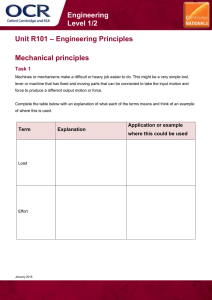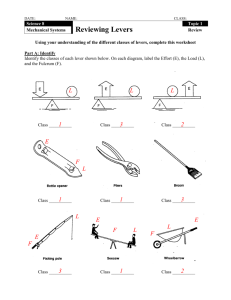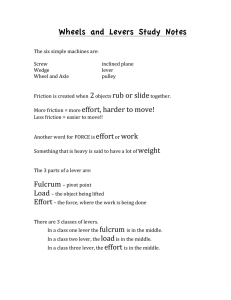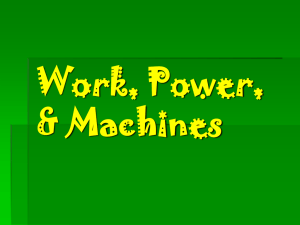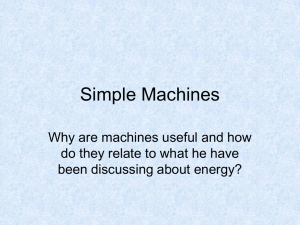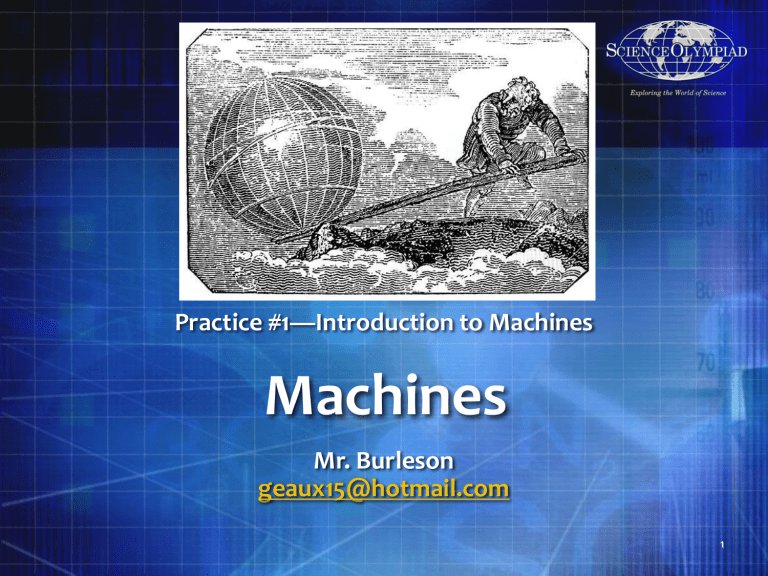
Practice #1—Introduction to Machines
Machines
Mr. Burleson geaux15@hotmail.com
1
Agenda
Introduction and Rules
Basics of Simple Machines
Simple Machines Practical
Homework
*huge thanks to Alan Chalker (National
Physics Chair) and Roger Demos (National
Event Supervisor) for their support
2
Tips for
Science Olympiad
Study often because all the work is done by you!
Use Teamwork for studying and practicing
Use the references, homework, and homework generators to practice
Know the rules better than anyone.
Check the national website often for updates and FAQs.
Practices are for covering material, sample tests, and practicing measurements—studying should be done at home
More practice will lead to better results
3
Introduction and Rules
Come prepared to practices with completed homework and all your questions
Listen and participate.
Be willing to study on your own and do more work than assigned
4
Machine Practice Timing
Recommendations
Each Practice should be an hour to an hour and a half, once a week.
15 minutes—Grading homework.
30 minutes—Learning Lesson of the Day
15 minutes—In Practice quick test on Lesson of the Day
25 minutes—Practical testing
5 minutes—Sending out homework
Each student who misses Practice should get the notes and homework to be ready for the next
Practice or they will receive zeros for both.
5
Team of 2
Machines (B)
Rules
No Eye Protection Required
Device must be impounded
Only five types of machines
Levers (all three classes)
Inclined Plane
Wedge
Pulley (up to two double pulleys)
Wheel and Axle
Part 1 (Written Test)
45% of score
Simple Machine Concepts
Simple Machine Calculations
Simple Machine History is no longer included
Part 2 (Device Testing)
55% of score
Two Ratio Scores (15% each)
One Time Score (15%)
Chart Score (10%)
Prohibited topics
Compound machines
Dynamic Calculations
Material Strengths
Potential/Kinetic Energy
Coefficient of Friction
Screw Simple Machines
Angle of Repose
6
Team of 2
Machines (C)
Rules
No Eye Protection Required
Device must be impounded
Part 1 (Written Test)
45% of score
Sim/Compound Machine
Concepts
Sim/Compound Machine Calcs
Sim/Compound Machine History is no longer included
All six types of simple machines
Levers (all three classes)
Inclined Plane
Wedge
Pulley (up to two double pulleys)
Wheel and Axle
Screw
Prohibited topics
Dynamic Calculations
Material Strengths
Angle of Repose
Part 2 (Device Testing)
55% of score
Two Ratio Scores (15% each)
One Time Score (15%)
Chart Score (10%)
7
Scoring for
Machines
Exam Score (ES) is worth maximum 45 points (45 points awarded to highest test score)
Time Score (TS) = ((240-time)/240*15 points (max 15 points)
Ratio Score (R1 and R2)=(1-(abs(AR-MR)/AR))*15 points (max 2x15 = 30 points)
Chart Score (CS) is worth 10 points (max 10 points)
2 points for including data spanning the possible mass range
2 points for including at least 10 data points in each data series
2 points for proper labeling (e.g. title, team name, units)
2 points for distinct graphs (0.5 points each up to 2 points)
2 point for including a labeled device diagram
Violations
Competition violate TS, R1, and R2 are multiplied by 0.9
Construction violation, if resolved during competition block or miss impound TS, R1, and R2 are multiplied by 0.7
Team with no device, no ratio estimate or do not make an HONEST attempt TS, R1, and R2 all marked zero
Final Score (FS)=ES+MS+TS+CS (maximum of 100 points)
Tie Breakers
1.
Best ES score
2.
Best TS score
3.
Best R1
4.
Best R2
8
Your Binder is Your
2” binder is new rule
Lifeline
A good binder is like having an open book test
Use your binder in all studying, practices,
When you have two or more pictures of the same thing, include
ALL of them (often Event
Supervisors will get diagrams and samples from the internet) and at tournaments
Always build your own binder in case something happens to your partner’s
First page should be the rules, so you can find them quickly
When you solve a difficult problem, show all your work and put that in the binder to help remind you how you solved that difficult problem
Always have easy to read tables for constants, materials, and equations
Keep the binder small enough to be useful, but big enough to be comprehensive
Organize into sections that work for you and your teammate with tabs for easy finding
Focus on the things you have to look up or don’t understand
Include other tests with keys and work shown
Test you skills at finding things in the binder each practice so that it takes no more than 10 seconds to find anything
Make sure you can read it (good fonts)
Use sheet protectors when possible
9
Basics of Simple
Machines
Lever
Inclined Plane
Wheel and Axle
Wedge
Pulley
Screw, not included in
Simple Machines (B)
10
Basic Definition of Simple
Machines
A simple machine is an elementary device that has a specific movement (often called a mechanism), which can be combined with other devices and movements to form a machine.
The idea of a "simple machine" originated with the
Greek philosopher Archimedes around the 3 rd century
BC, who studied the "Archimedean" simple machines: lever, pulley, and screw
Thus simple machines are considered to be the
"building blocks" of more complicated machines.
A bicycle has wheels, levers, and pulleys
11
Mechanical Advantage
A simple machine has an applied force (or effort) that works against a load force.
If there are no friction losses, the work done on the load is equal to the work done by the applied force.
This allows an increase in the output force at the cost of a proportional decrease in the distance moved by the load.
The ratio of the output force to the input force is the mechanical advantage of the machine.
12
Efficiency
Machines lose energy through friction, deformation and wear, which is dissipated as heat.
This means the power out of the machine is less than power in.
The ratio of power out to power in is the efficiency η of the machine, and is a measure of the energy losses.
13
What is a Lever?
A lever is a machine consisting of a beam or rigid rod pivoted at a fixed hinge, or fulcrum
The word comes from the French lever, "to raise", cf. a levant.
A lever amplifies an input force to provide a greater output force, which is said to provide leverage.
The ratio of the output force to the input force is the ideal mechanical advantage of the lever.
14
Classes of Levers
Class 1: Fulcrum in the middle: the effort is applied on one side of the fulcrum and the resistance on the other side
A crowbar or a pair of scissors.
Class 2: Resistance in the middle: the effort is applied on one side of the resistance and the fulcrum is located on the other side.
A wheelbarrow, a nutcracker, a bottle opener or the brake pedal of a car. Mechanical advantage is greater than 1.
Class 3: Effort in the middle: the resistance is on one side of the effort and the fulcrum is located on the other side
A pair of tweezers or the human mandible.
Mechanical advantage is less than 1.
15
IMA of Lever/Law of the
Lever
If a and b are distances from the fulcrum to points A and B and let the force FA applied to
A is the input and the force FB applied at B is the output, the ratio of the velocities of points A and B is given by a/b, so we have the ratio of the output force to the input force, or mechanical advantage, is given by
16
In Practice Quiz
Think of as many levers you can, including around the house, construction sites, school, etc.
Workshop tools
Garden tools
Kitchen tools
Think of as many places where you can lose efficiency with a lever
17
Things to consider
Winners prepare
No one knows this material naturally, those that prepare the best will do better.
Study and do homework before practice, use practice for asking questions
Plan on doing work on this a few times a week in addition to practice
Winners work together
Be a good partner
Work off each other strengths
Practice together
Event Supervisors are volunteers
They have given up their time to prepare for the competition, run the event, score, etc.
Some are more experienced than others
Some know the rules more than others
Be respectful and work with them
Always listen to instructions and read the test before you ask your questions
Different Event Supervisors ask the same question differently
18
Arguing an Illegal
Question
Always make sure you read the question again to ensure it really is illegal.
Event supervisor might have old rules, but double check your rules first.
Ask for how to implement the question within the rules.
Remove the illegal items like capacitors/inductors/LEDs/etc.
Operate it as DC instead of AC.
Reference the specific rule, normally in section 3.d
Semiconductors include diodes, LEDs, transistors, OpAmps, and integrated circuits. LEDs, Diodes and OpAmps are now allowed in certain circumstances.
AC circuit theory includes frequency analysis, two or three phase power, capacitor/inductor reactance. But they can sometimes be made legal by switching to a DC system.
AC devices include transformers, rectifiers, others. Most will not work with DC.
Several items are only available for Division C and not for B
19
Practical
Each team will use a ruler and several small objects.
If you have something to balance the ruler on top of you can use that as your fulcrum, otherwise use your finger
First, balance the ruler on the fulcrum point
Is the balance point near the middle of the ruler
Note when the ruler is not near the balance point, how does it rotate
Second, start with the balanced ruler and then have the second person put two of the same small objects on the ruler to find where they balance
Third, start with a balanced ruler and then have the second person put two different small objects on the ruler to find where they balance
20
Suggested References
Websites:
• Soinc.org Simple Machines/ Complex Machines Event pages
• Scioly.org student forums / wiki / test exchange
• Wikipedia (Simple Machines, Levers, Pulleys, etc.)
• http://www.khanacademy.org/#Physics
Khan Academy Tutorial on Mechanical Advantage
Museum of Science and Industry Simple Machines online game
SEDL Simple Machines Online Textbook
Department of Navy - Basic Machines Textbook
21
How to use the
Homework Generator
Homework generator is a Microsoft Excel workbook with multiple tabs
The tabs are broken down into levels (start with Level 1 and work your way up)
Work on accuracy first, so don’t start Level 2 until you can you do all of
Level 1 with 100% accuracy at least three whole sheets
A good way to improve speed is to see how many problems or sheets you can do in 5 min (after you are accurate)
Some tabs have reference material, but most only have problems
The numbers used in problems are from a random number generator
If on a Windows machine you can refresh using F9
You can also refresh by reopening the workbook, printing, or saving the file
Every time it is refreshed it randomly comes up with new problems and corresponding answer sheets.
22
Homework #1
Do the Homework Generator problems for Levers
Level 1
Go through the house and write down as many of the six simple machines as you can at home.
We will study more levers next in depth.
23
